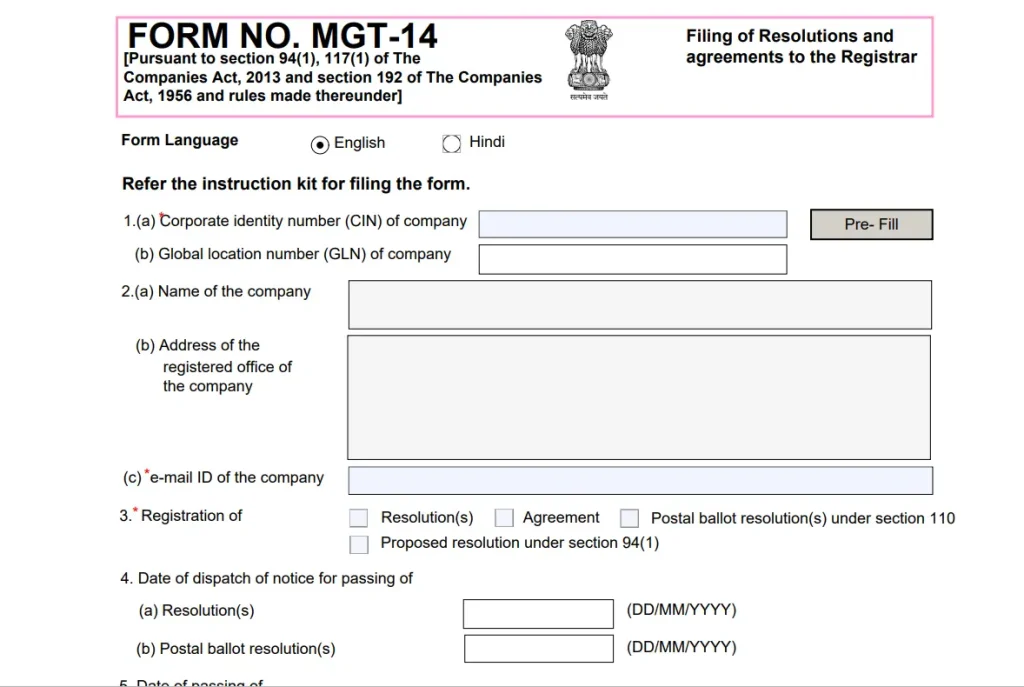
Companies often change their names to reflect growth, rebranding, mergers, or a new business direction. Although the company’s name changes, the legal entity’s identity, liabilities, and obligations remain the same.
It’s important to follow the correct legal process to avoid compliance issues or operational delays while changing names. This guide explains why companies change their names, outlines the legal process under the Companies Act, 2013, and provides clear steps to complete the transition smoothly. It applies to all Indian entities, including Private Limited, Public Limited, and One Person Companies (OPCs).
Why Do Companies Change Their Name?
Companies decide to change their names for various strategic and legal reasons. A name isn’t just a label; it’s a reflection of identity, purpose, and market position. Here are some of the most common motivations behind a company name change in India:
- Rebranding or Repositioning: Companies change their names to match a new vision, product range, or audience. A new name helps them reintroduce the brand, attract modern customers, and highlight growth.
- Mergers or Acquisitions: When two businesses merge or when new owners take charge, they often adopt a new name. The new name represents their combined identity and future direction.
- Legal or Trademark Conflicts: Companies change names when their existing ones conflict with another registered entity or trademark. Doing so helps them avoid legal issues and maintain brand integrity.
- Expansion Into New Markets: When companies enter new or international markets, they often choose names that appeal to a wider audience. This makes the brand sound more global and inclusive.
- Modernization: Businesses update old or complex names to sound fresh, simple, and relevant in today’s digital world.
- Regulatory or Compliance Requirements: Sometimes, the Ministry of Corporate Affairs (MCA) may direct a company to change its name if it is too similar to another registered name or violates Section 16 of the Companies Act.
A carefully chosen new name builds trust, strengthens credibility, and improves brand recognition.
Legal Framework for Company Name Change: What the Law Says?
The Companies Act, 2013, governs the process of changing a company name under Sections 13(2) and 13(6), along with Rule 29 of the Companies (Incorporation) Rules, 2014.
The name of a company can be changed by obtaining approval from the Registrar of Companies (ROC), under the supervision of the Ministry of Corporate Affairs (MCA). In certain cases, the Central Government also approves the change, especially when specific regulatory conditions apply.
When applying for the Registrar of Companies (ROC), businesses must include a Company Name Change Letter formally stating the reason for the change, board approval details, and authorization for filing. This letter supports compliance verification and ensures the process moves forward without delays.
The ROC issues a fresh Certificate of Incorporation after approving the new name. This certificate makes the name change official while keeping the company’s legal identity, rights, and liabilities intact.
What is the Process to Change a Company Name in India?
Here is the procedure for changing the name of a company under the Companies Act 2013:
1. Hold a Board Meeting and Pass a Resolution: Conduct a board meeting to propose the new name. Authorize a director or professional to check name availability and file the necessary company name change form on the MCA portal. Pass a Board Resolution approving the name change.
2. Check Name Availability: Use the RUN (Reserve Unique Name) service on the MCA portal (mca.gov.in) to verify name availability. Ensure compliance with Companies (Incorporation) Rules, 2014, and avoid duplication. The approved name stays reserved for 20 days.
You can use RegisterKaro’s free company name check tool to check the availability of your chosen name.
3. Pass a Special Resolution: Hold an Extraordinary General Meeting (EGM) to get shareholder approval through a Special Resolution. Record and store meeting minutes in the company records.
4. File Form MGT-14 with the ROC: Submit Form MGT-14 within 30 days of the resolution. Attach:
- Certified copy of the Special Resolution
- EGM notice with explanatory statement
- Updated Memorandum of Association (MOA) and Articles of Association (AOA)

5. File Form INC-24 for Approval: Submit Form INC-24 to seek ROC and Central Government approval. Include board and shareholder resolutions, required approvals, and updated MOA and AOA. Pay the prescribed ROC fee based on company type.

6. Receive New Certificate of Incorporation: Once approved, the ROC issues a Certificate of Incorporation. The new name becomes valid from the date on the certificate.
7. Update Records and Registrations: Update the new name on:
- PAN, TAN, GST, and bank accounts
- Licenses, trademarks, and statutory filings
- Letterheads, seals, websites, and contracts
On average, the entire process takes 15 to 25 working days, depending on MCA approval speed and documentation accuracy.
Key Documents Required to Change Company Name
To change a company’s name in India, you must prepare and submit several key documents to the Registrar of Companies (ROC). These documents ensure compliance and smooth processing of your application.
Mandatory Documents:
- Board Resolution Copy: Approves the proposal for name change and authorizes filing.
- Notice of EGM and Explanatory Statement: Sent to shareholders before the meeting.
- Certified Copy of the Special Resolution: Confirms shareholder approval for the new name.
- Altered MOA and AOA (with new name): Updated to reflect the approved name.
- Copy of Old MOA and AOA: For ROC reference and record comparison.
- Minutes of Board Meeting and Attendance Sheet: Verify the meeting’s authenticity.
- Approval Letters from Regulatory Authorities (if required): For companies regulated by RBI, IRDA, SEBI, or other government bodies.
- Existing Certificate of Incorporation: Proof of the company’s registration.
- Digital Signature of Authorized Person: Used for electronic filings with the ROC.
- List of Shareholders and Directors: Provides company ownership and management details.
Note: If the company operates in a regulated sector such as NBFCs (RBI), insurance (IRDAI), capital markets (SEBI), or telecom (DoT), prior approval from the respective authority must be obtained before filing Form INC-24.
Additional / Optional Documents:
Public companies, listed entities, and regulated sectors may need:
- Stock Exchange Intimation or Approval: For listed companies.
- Sectoral Consent Letters: For NBFCs, insurance firms, or telecom companies.
- Updated Compliance Certificate: Issued by a practicing Company Secretary for larger entities.
Having the right set of documents is crucial for a seamless transition, including supporting paperwork like a request letter for a change of company name in the bank account. This ensures that all financial and regulatory records remain consistent with the new company name.
Post-Approval Formalities & Practical Steps to Follow After Changing a Company Name
Once the ROC issues the new Certificate of Incorporation, the new company name becomes legally effective. The company must update all records and communications to reflect this change. Some post-approval compliances after changing the name of a company are:
- Update Registrations: Update the new name on PAN, TAN, GST, and other statutory registrations like Import Export License, ESI, and PF.
- Inform Banks: Notify your banks and update account details, cheques, and digital records with the new name.
- Revise Branding Materials: Change the name on letterheads, invoices, websites, signage, and other communication materials.
- Inform Clients and Partners: Send official notices to clients, vendors, and partners to maintain trust and avoid confusion.
- Update Contracts: Amend all active contracts, Memorandum of Understanding (MOU), and legal agreements with the new company name.
- Maintain ROC Compliance: Ensure all filings and future submissions on the MCA portal (mca.gov.in) reflect the updated name.
These quick updates keep your legal, financial, and business records consistent after the name change.
Common Mistakes & Pitfalls to Avoid While Changing Company Name
Many companies face delays or rejections during a name change due to simple but costly mistakes. To ensure a smooth process, follow a proper checklist for the change of name of a listed company that covers approvals, filings, and documentation. Avoid these common errors to ensure a smooth process:
- Ignoring Compliance Defaults: Failing to clear existing ROC or tax defaults can lead to immediate rejection of the name change application.
- Choosing a Conflicting Name: Selecting a name too similar to an existing company or trademark often invites objections or legal disputes. Before reserving a new name, conduct a Trademark Search and MCA Name Availability Check to ensure that the proposed name isn’t identical or deceptively similar to an existing company or registered trademark.
- Missing Proper Approvals: Skipping board or shareholder approvals or issuing incorrect meeting notices violates compliance norms.
- Delaying Form Filings: Forms like MGT-14 must be filed within 30 days of passing the resolution. Late filing attracts penalties.
- Neglecting Post-Approval Updates: Not updating PAN, GST, bank accounts, and licenses can cause operational and financial mismatches.
- Failing to Inform Stakeholders: Lack of clear communication to clients, partners, and employees can create confusion and mistrust.
- Underestimating Rebranding Costs: Companies often overlook the expenses and time needed for updating signage, stationery, and digital assets.
Staying proactive, organized, and compliant helps companies complete the name change efficiently without facing unnecessary delays or penalties.
Wrapping Up
Changing a company name helps businesses redefine their identity and align with new goals. A well-executed name change strengthens credibility and ensures compliance with the Companies Act, 2013.
By following each step carefully, from resolutions to ROC approval, companies can complete the process smoothly and continue operations under their new name without disruption.
Frequently Asked Questions
No, changing the company name does not affect the company’s legal entity. All rights, obligations, assets, and liabilities remain the same. Existing contracts, registrations, and licenses continue under the new name. The change only alters the company’s identity, not its structure or legal existence.




